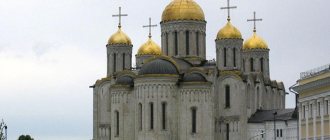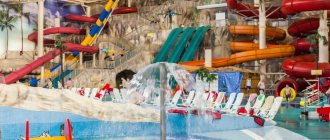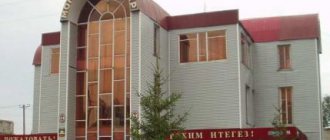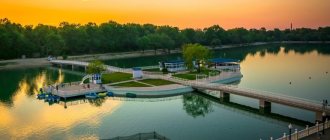Where is Cherkessk?
Cherkessk is a city of republican significance, which is located in the southern part of Russia and is the capital of the Karachay-Cherkess Republic.
The municipality of the city of Cherkessk has the status of an urban district. It is located in the northern part of Karachay-Cherkessia, on the right bank of the Kuban River. In the north, the city borders on the Adyge-Khablsky district, in the west - on the Abaza region. Cherkessk is located in the foothills zone: to the east of the city there are hilly ridges, the maximum height of which reaches 700 m above sea level. The main industrial, cultural and economic center of the republic. The approximate population is 122 thousand people, the territory area is 70 square kilometers.
The climate in the city of Cherkessk is moderately humid. This climate is characterized by warm, humid winters and hot summers. The annual precipitation rate is 650 mm. Cherkessk is located in the same time zone as Moscow, the offset relative to Coordinated Universal Time (UTC) is +3.
National picture
The population of the city of Cherkessk is people of 80 nationalities living in peace and harmony. Most of the inhabitants are Russians, Karachais, Circassians, Nogais and Abazas.
Ukrainians and Ossetians, Armenians and Tatars, Greeks and Azerbaijanis, Gypsies and Kabardians live in the capital of Karachay-Cherkessia. There are even representatives of small peoples - Laks, Kumyks, Avars and Dargins.
The population of Cherkessk professes Islam, Orthodoxy, Catholicism and Protestantism.
But mutual understanding and peace did not always reign in these lands.
Cherkessk Airport
The city of Cherkessk does not have its own airfield. The nearest airport is in Mineralnye Vody. The distance from Cherkessk to the airport is 98 km. The international airport in Mineralnye Vody has the status of a federal facility. It is the largest airfield in the North Caucasus Federal District and one of the largest airports in the south of Russia. Airfield type: civil. Operating hours: 24 hours a day.
The airport serves aircraft of major Russian and international airlines: Ural Airlines, Aeroflot, Azimut, UTair, Pegasus Airlines, FlyDubai. Popular destinations of regular and charter flights: Istanbul, Moscow, St. Petersburg, Yerevan, Yekaterinburg. Annual passenger traffic is more than 2.4 million people.
Names
In Russian the city is called Cherkessk ( Cherkessk
)[7] and has similar names in the languages of the city's other major ethnic groups.
In Karachaevsky, it is Cherkessk ( Cherkessk
)[7] or Cherkessk shahar (
Cherkessk Shahar
);
in Kabardin, it is Sherdzhes qală ( Ărdjăs qală
) or Cherkessk (
Cherkessk
);[7] in Abaza, it is Cherkes qala (
Čerkes q̇ala
) or Cherkessk (
Cherkessk
);[7] in Nogai, it is Sherkesh shahar (
Erkeş şahar
) And in Chechen, this is Cherkessk (
Cherkessk
).
For the first century of its existence, Cherkessk was a village
, a village within the Cossack army, which from 1825 to 1931 was called
Batalpashinskaya stanitsa
(Russian: Batalpashinskaya stanitsa
Batalpashinskaya stanitsa
)[7] and nicknamed
Pashinka
(Pashinka
Pashinka
) In 1931 it was renamed
Batalpashinsk
(Batalpashinsk
Batalpashinsk
),[8] [7] and then in quick succession
Sulimov
(Sulimov
Sulimov
) in 1934.[8][7]
for Daniil Sulimov, Chairman of the Council of People's Commissars of the RSFSR, and after the execution of Sulimov in the Great Purge, Yezhovo-Cherkessk
(Ezhovo-Cherkessk
Ezovo-Cherkessk
) in 1937.[8][7] for Nikolai Yezhov, head of the NKVD. With Yezhov's arrest, the initial "Ezhovo-" was dropped, and the city received its current name in 1939.[8][7]
Automobile highways
The following roads pass through Cherkessk:
- P217 "Caucasus" is a highway that has the status of an object of federal significance. The length of the route is 1118 km. It is part of two European routes: E119 and E50. The road passes through the territory of the following regions of Russia: Chechnya, Krasnodar Territory, North Ossetia, Kabardino-Balkaria, Stavropol Territory, Ingushetia, Dagestan. The final point of the route is the state border with Azerbaijan.
- P265 is a regional highway with a total length of 121 km. The route starts in Cherkessk and passes through Khabez, Kardoninskaya, Nizhny Arkhyz, Arkhyz.
- A165 is a federal highway with a length of 79 km. The route leads from Pyatigorsk to Cherkessk.
Religion in Cherkessk
The population of this small city professes different religions and is tolerant of each other's faith. There are few architectural and historical monuments in Cherkessk, but there are plenty of churches, mosques and temples.
There are Orthodox churches: St. Nicholas Cathedral, the Church of the Intercession and St. George the Victorious, the Church of St. Sergius of Radonezh.
Armenian services are held in the Church of St. George. There is a Protestant church.
The huge 33 domes of the Cathedral Mosque of Cherkessk cannot be missed from afar. The mosque is located in the city center next to the A-155 highway leading to the Teberda ski resort. The mosque was built recently, in 2007, and it can accommodate five thousand worshipers at the same time.
There are 3 more mosques in different areas of the city.
Such religious diversity affects the mentality of the residents. They are good-natured and calmly treat visitors and non-religious people.
What is the city of Cherkessk famous for?
- On the territory of the city of Cherkessk there is a park of culture and recreation "Green Island", which is one of the largest park areas in the southern part of Russia. The area of the park is 90 hectares. There are a large number of walking areas, cafes, pedal boats, billiards, a shooting range, etc.
- In the Green Island park there is the Lukomorye alley. The alley contains various wooden sculptures of fairy-tale characters. Visitors can also see scenes from popular fairy tales here.
- In Cherkessk there is the Karachay-Cherkess Natural and Historical and Cultural Museum-Reserve. The museum's collection includes more than a thousand different exhibits that tell visitors about the history of the region and nature.
- On Lenin Street, opposite the City Hall, there is a light and music fountain, which was opened in 2009. Every evening a water show is held here, which hundreds of city residents gather to watch.
- There is also an open-air amphitheater on the territory of the Green Island park. The building was built in antique style. The building is decorated with columns and statues of Greek gods. The amphitheater seats more than 1,000 people.
- In 1992, the Drama Theater named after M. O. Akov opened in the city. Today, the theater troupe tours nearby cities and towns. The theater's repertoire includes works by Russian and foreign classics, puppet shows, and children's performances.
- Near Cherkessk, in the Bolshoi Zelenchuk gorge, there is the Northern Zelenchuk Temple - the historical, spiritual and cultural heritage of local churches. The temple was built in Byzantine style from sandstone.
HELPFUL INFORMATION
History of the city of Cherkessk
The settlement was founded in 1825 on the site of a former military fortification - the Batalpashinsky Cossack redoubt, which bore this name since 1804 on the basis that 14 years earlier, in September 1790, the army of General Ivan German here defeated the army of the Turkish seraskir Batal - Pasha.
The original name of the settlement was the village of Batalpashinskaya - a rare case when a settlement was named after the vanquished, and not the winner. Almost a quarter of a century later, the village was renamed the city of Batalpashinsk, and a year later, on June 16, 1922, by the Resolution of the Presidium of the All-Russian Central Executive Committee, Batalpashinsk was officially renamed into the provincial city of the united Karachay-Cherkess Autonomous Region, becoming its administrative center.
In 1934, Batalpashinsk was transformed into the city of Sulimov in honor of the Chairman of the Council of People's Commissars of the RSFSR D. Sulimov. Three years later, Sulimov was repressed, the city began to be called Yezhovo-Cherkessk, in honor of the People's Commissar of Internal Affairs N. Yezhov. In 1939, Yezhov was arrested, and only the second part of the name remained outside the city - Cherkessk, which has not changed since then. At the end of the thirties, the first large industrial enterprise in Karachay-Cherkessia opened in the city - an iron foundry, now a refrigeration engineering plant.
During the Great Patriotic War, Cherkessk was occupied on August 11, 1942, liberated on January 17, 1943. Hundreds of townspeople voluntarily went to the front in the ranks of the cavalry corps of generals Dovator, Oslikovsky, Kirichenko. During the occupation, the Circassian city and district partisan detachments were formed, which, as part of the partisan association, took on the first blows of selected regular units of the German Edelweiss division. The streets of the city are now named in honor of the war heroes I. Lobodin, Kh. Bogatyrev, I. Laar, O. Kosayev, D. Starikov and others. The monument “Fire of Eternal Glory” in Victory Park, a monument to the soldiers of the Soviet Army near the mass grave, is dedicated to the memory of the defenders and liberators of Cherkessk.
In 1956, a master plan for the development of the city was developed, according to which Cherkessk was conditionally divided into three microdistricts. Central, as the name implies, is the industrial, transport, administrative, economic and cultural center of the city, where the largest public buildings are concentrated - the republican and city administrations, the Main Post Office, the Drama Theater, etc. The northern microdistrict is mainly industrial, and the southern one is an area of new buildings and individual houses.
Since 1957, Cherkessk has been the center of the Karachay-Cherkess Autonomous Region, and in 1991 it officially received the status of the capital of the Karachay-Cherkess Republic.
In 2001, deputies of the city Duma, having considered more than thirty options, approved the coat of arms of Cherkessk, the author of which was the system administrator of the general department of the city administration, Dmitry Kosarev.
The coat of arms is a red shield, at the top of which there are four square teeth - a memory that the village of Batalpashinskaya, on the site of which Cherkessk later appeared, was founded as a line designed to hold back enemies. In the center of the shield is a golden stele, a monument installed at the central entrance to the Green Island Culture and Recreation Park and personifying the eternal friendship of peoples living together. Below are three blue stripes - three rivers flowing through the city: Kuban, Abaza and Ovechka.
Modern Cherkessk is a developing city with a total area of 69.8 square meters. kilometers with a population of 126.2 thousand people - representatives of more than 80 nationalities. Five of them are subject-forming. These are Russians, Karachais, Circassians, Abazas and Nogais.
Cherkessk is connected by a railway line with Nevinnomyssk, and by highways with Krasnodar, Nevinnomyssk and Pyatigorsk.
Cherkessk occupies a leading position in the economic potential of Karachay-Cherkessia; about 56% of the republic's industrial output is produced here, 56% of the total area of residential buildings is introduced and more than 76% of the total turnover of the consumer market is formed.
There are about three thousand organizations and enterprises in the city. The most famous of them are the automobile, group, OJSC "Cherkessian Plant of Rubber Technical Products", the wool processing and yarn production factory "Quest-A" LLC, "Kholodmash" OJSC, "Kaskad" OJSC, "YUG-oil-PLAST" LLC. , LLC "Bumfa Group", JSC PTSHF "Ine", JSC "Visma", JSC "Aqualine", JSC RAPP "Kavkaz-myaso", JSC "Yug-Moloko", LLC "Khladokombinat", LLC "Cherkesskkhleb", Confectionery factory "Dahanago."
The municipal education system consists of 21 preschool institutions, 18 general education and additional education institutions, where more than 25 thousand children come daily.
City healthcare includes 6 municipal institutions, 5 of which provide medical care to the population and a specialized children's home to provide medical and social assistance to children without parental care.
In the spring of 2015, independent experts conducted a survey of citizens about living conditions in Cherkessk. About 250 residents of the republican center of various social groups and ages answered the questions. More than two-thirds of citizens believe that Cherkessk is convenient for life, 74% of respondents are satisfied with the improvement of the city, 64% are satisfied with the work of public transport, more than half agree that the local government is doing a lot for the city.
Education
Circassian Academy
The following educational institutions operate in Cherkessk:
- North Caucasus State Academy: civil engineering, mechanical engineering, energy, business management, accounting, finance, medical school. www.kchgta.ru[15]
- Moscow Social Open University (branch)
- Moscow Institute of Contemporary Art (branch)
- Rostov State Economic University (branch)
- Karachay-Cherkess State College
- Daurov Art School: art, interior, music, choreographic sections
- Republican children's art school: music, art, choreographic sections
Population
Circassian Mosque St. Nicholas Cathedral, Cherkessk
The population of Cherkessk was 129,069 people. 2010 Census,[1] 116,244 in the 2002 Census[11] and 113,060 in the 1989 Soviet Census.[12]
Ethnic groups
The city is populated by Russians, native Circassians (Circassians), Karachays, Abazas, Nogais and minorities Ukrainians, Greeks and Armenians.
1926
According to the First All-Union Population Census of the Soviet Union, as of 1926, among the residents of Batalpashinsk (modern Cherkessk) were:[13]
- Russians (82.7%)
- Ukrainians (9.0%)
- Karachais (0.8%)
- Greeks (Pontic Greeks) (0.2%)
1939
The 1937 Census results were suppressed and destroyed, but the 1939 Soviet Census recorded:[13]
- Russians (87.6%)
- Ukrainians (3.6%)
- Abazins (1.5%)
- Adygs (i.e. Circassians) (1.4%)
- Karachais (0.8%)
- Ossetians (0.5%)
- Nogais (0.5%)
- Greeks (0.5%)
1959
The Soviet census of 1959 recorded:[13]
- Russians (87.7%)
- Ukrainians (2.8%)
- Circassians (2.1%)
- Abazins (1.8%)
- Karachais (1.6%)
- Nogais (0.4%)
- Greeks (0.4%)
- Ossetians (0.4%)
1970
The Soviet census of 1970 recorded:[13]
- Russians (74.5%)
- Circassians (6.4%)
- Karachais (6.2%)
- Abazins (5.0%)
- Ukrainians (2.1%)
- Nogais (1.0%)
- Greeks (0.5%)
- Ossetians (0.5%)
1989
According to the 1989 last Soviet census, the city's population included:[13]
- Russians (67.8%)
- Circassians (9.0%)
- Karachais (7.8%)
- Abazins (6.5%)
- Ukrainians (2.2%)
- Nogais (1.2%)
- Ossetians (0.5%)
- Greeks (0.5%)
2002
In 2002, the Russian Census reported the population, including:[14]
- Russians (55.5%)
- Karachais (13.8%)
- Circassians (12.6%)
- Abazins (8.1%)
- Nogais (1.5%)
- Ukrainians (1.3%)
- Ossetians (0.6%)
- Greeks (Pontic Greeks) (0.4%)
- Other (6.1%)
2010
In 2010 the population included:[ citation needed
]
- Russians (54.7%)
- Karachais (16.4%)
- Circassians (13.2%)
- Abazins (8.2%)
- Nogais (1.5%)
- Other (6.0%)




